Contact Frequency Rules
As of release 6.2, a contact frequency rule is applicable to SMS, MMS, and Email channels only.
The contact frequency capping feature is used to control the maximum number of messages sent out to audience contacts depending on the channel and message purpose for defined time windows. This can help prevent sending more than the desired number of messages to the contacts and avoid messaging fatigue.
A rule can be switched on and off during a deployment creation. A good example of when it may be necessary to turn off the contact frequency rule is when an important service message must be sent to all customers, irrespective of the customer’s marketing communication preferences.
If a deployment is in a running state and a new rule is created, then you should pause the deployment and resume to apply the rule. For a recurring deployment, the new rule gets applied automatically from the next run.
Add a Contact Frequency Rule
- Navigate to Administration > Tenant management > Contact frequency rules.
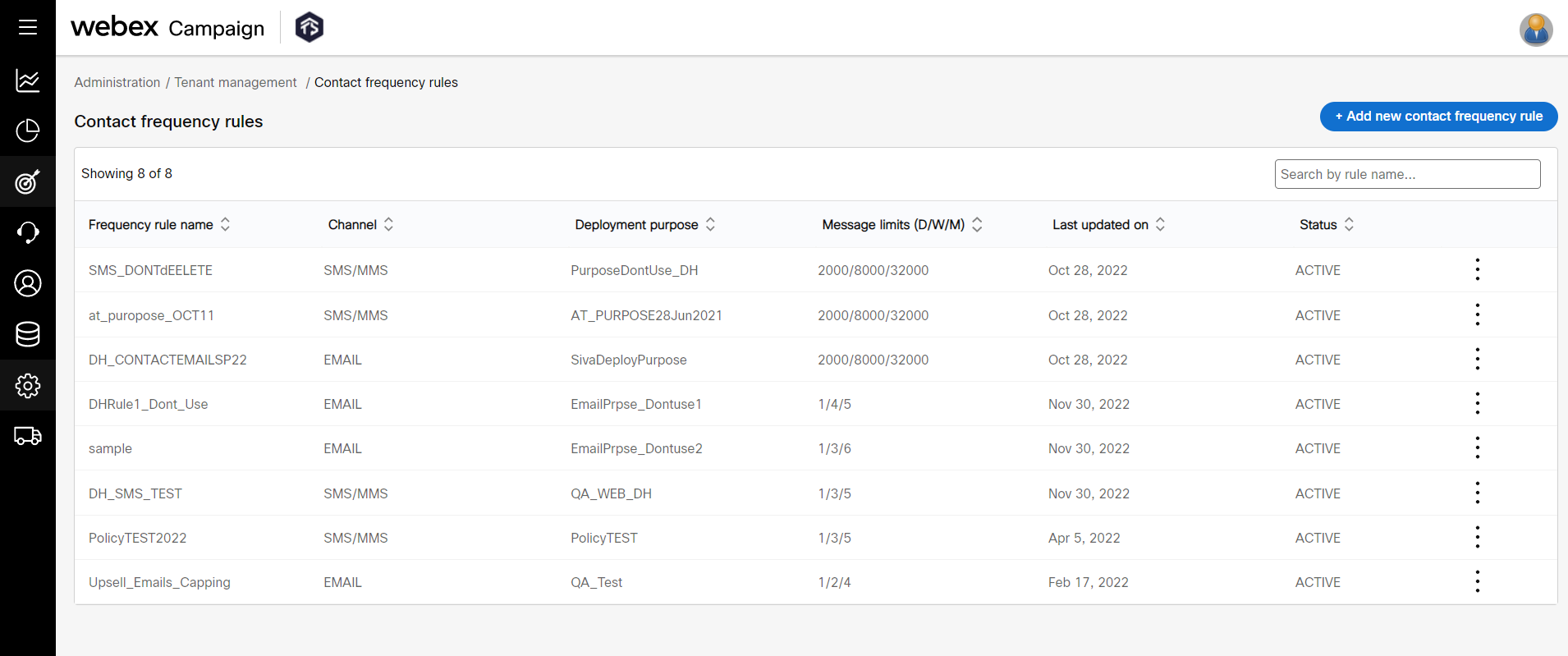
2.Click + Add new contact frequency rule.
- Enter details for the following fields:
- Contact frequency rule name: Enter a name to identify the rule.
- Description: Enter a description for the rule.
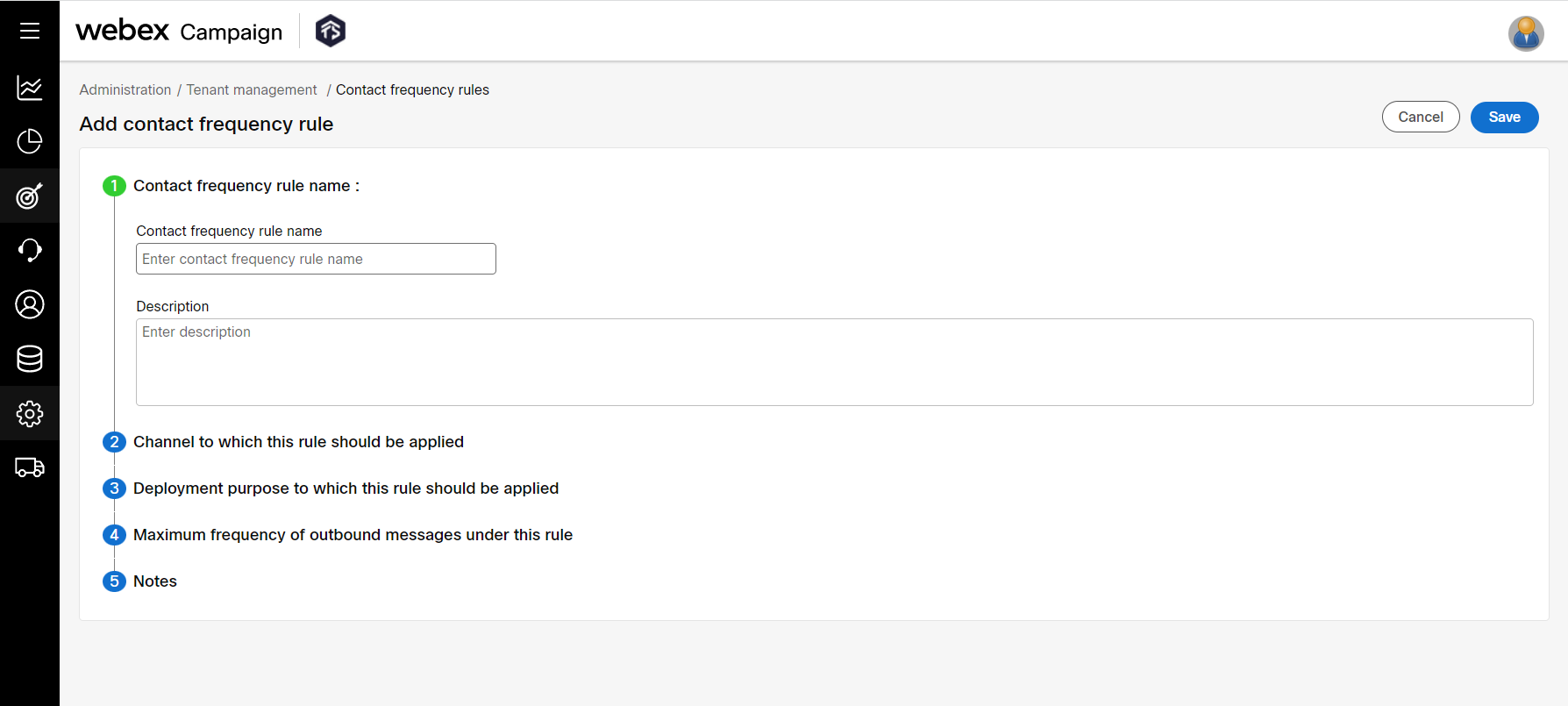
- Select the channel on which the rule should be applied.
You can choose one of SMS/MMS or Email as options. For SMS and MMS channels, the contact identifier is a mobile phone number and hence all messages to the contact’s phone number will be considered as sent messages.
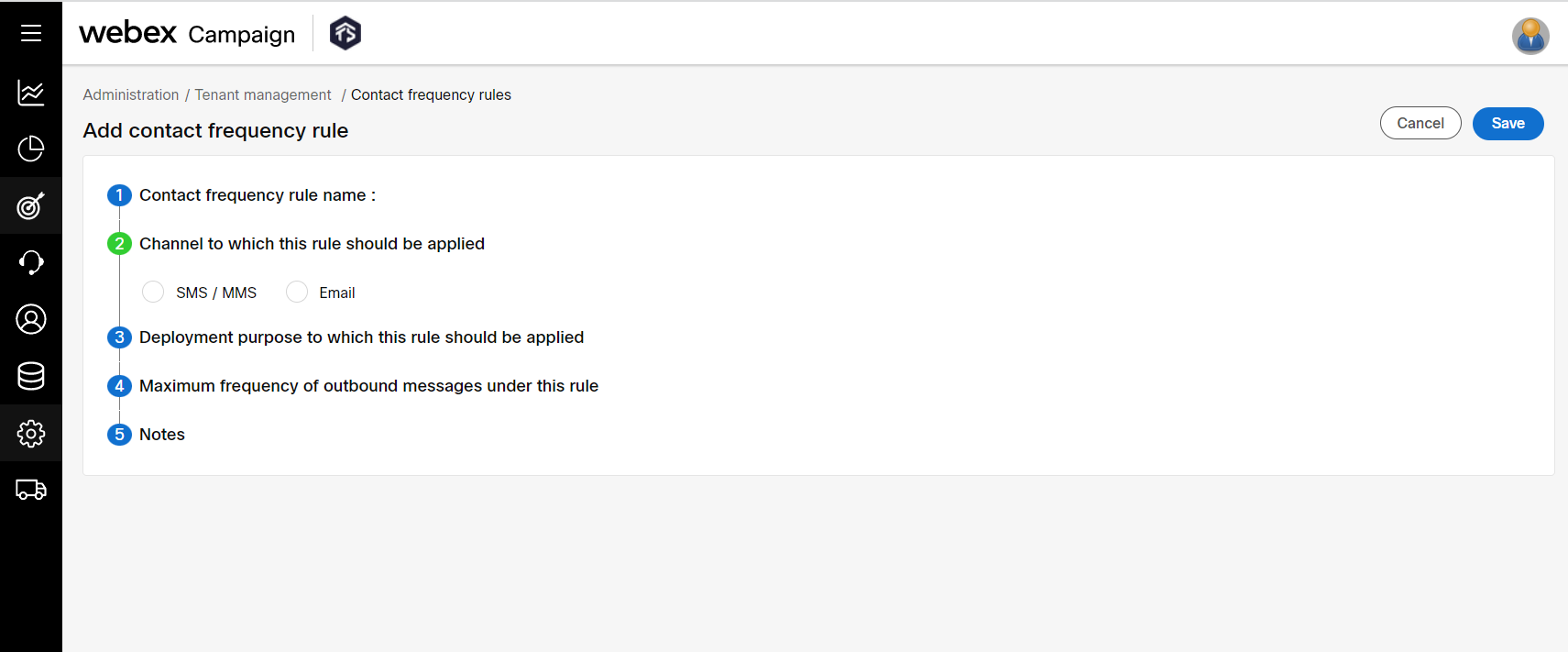
- Select the purpose to which the rule should be applied.
You can only select one Purpose from the drop-down. All deployments which use this selected Purpose as a meta-tag will have the frequency capping rule applied to them automatically.

- Configure maximum frequency of Outbound messages
The maximum frequency is specified in terms of messages ‘per day’, ‘per week’ and ‘per month’. If this rule is applied to a deployment and a targeted contact has received equal or a greater number of messages for the day, week, or month across deployments than the value permitted by the applied rule, then the contact will be suppressed during TG preparation and the contact will not receive the outbound message.

- Click Save.
Applying Contact Frequency Capping Rules
The Frequency capping rule will be applied automatically to SMS, MMS, and Email deployments after the Deployment Purposes are specified - if any of those Purposes have any active frequency-capping rules associated with them. One deployment can have multiple rules applied to it, depending on the selected purposes. Frequency Capping is enabled by default. You can choose to disable the “Apply contact frequency rule” option under the “Additional options” node on the deployment.
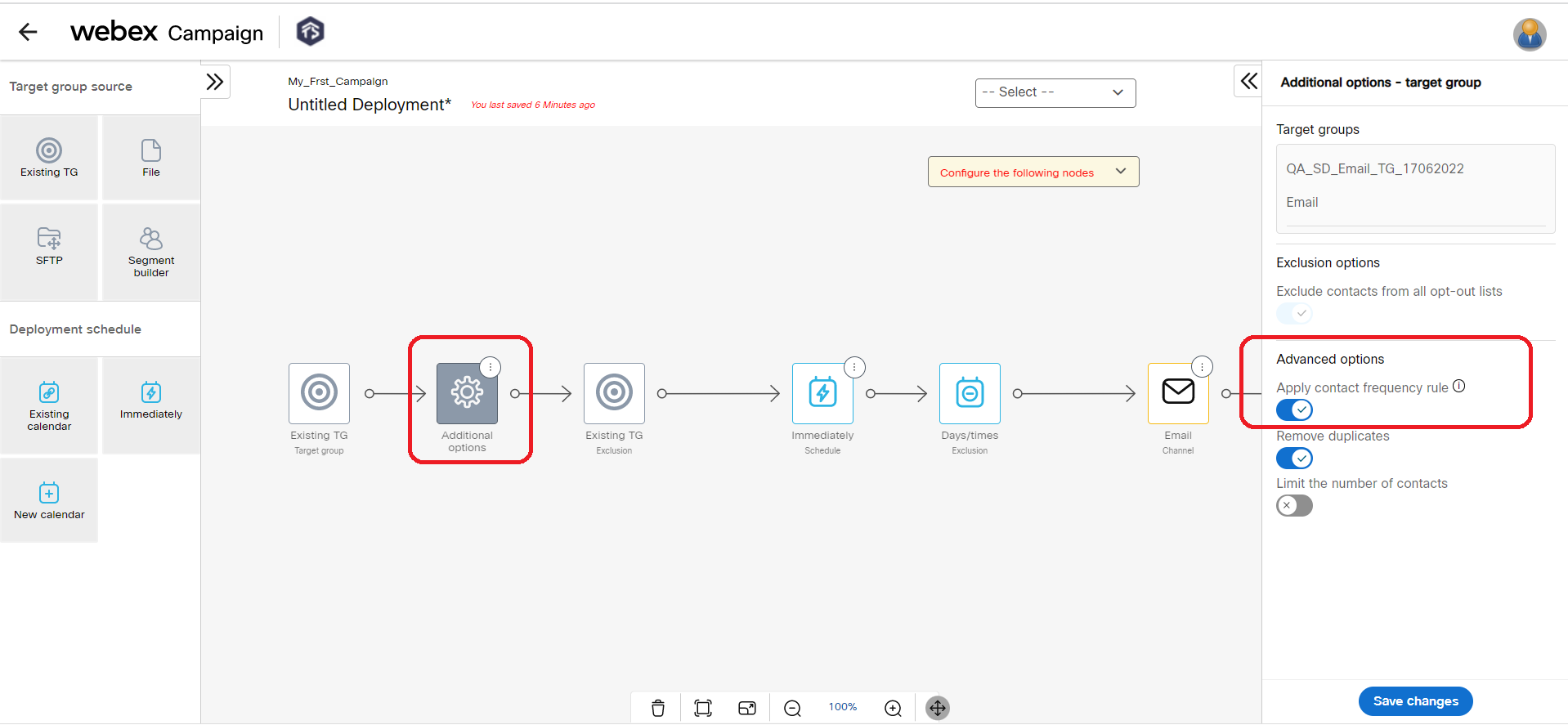
If ‘Purpose’ meta-tags have been applied to the deployment, then hovering on the “i” information icon next to the “Apply contact frequency rule” toggle will show the rules which will be applied to the deployment.
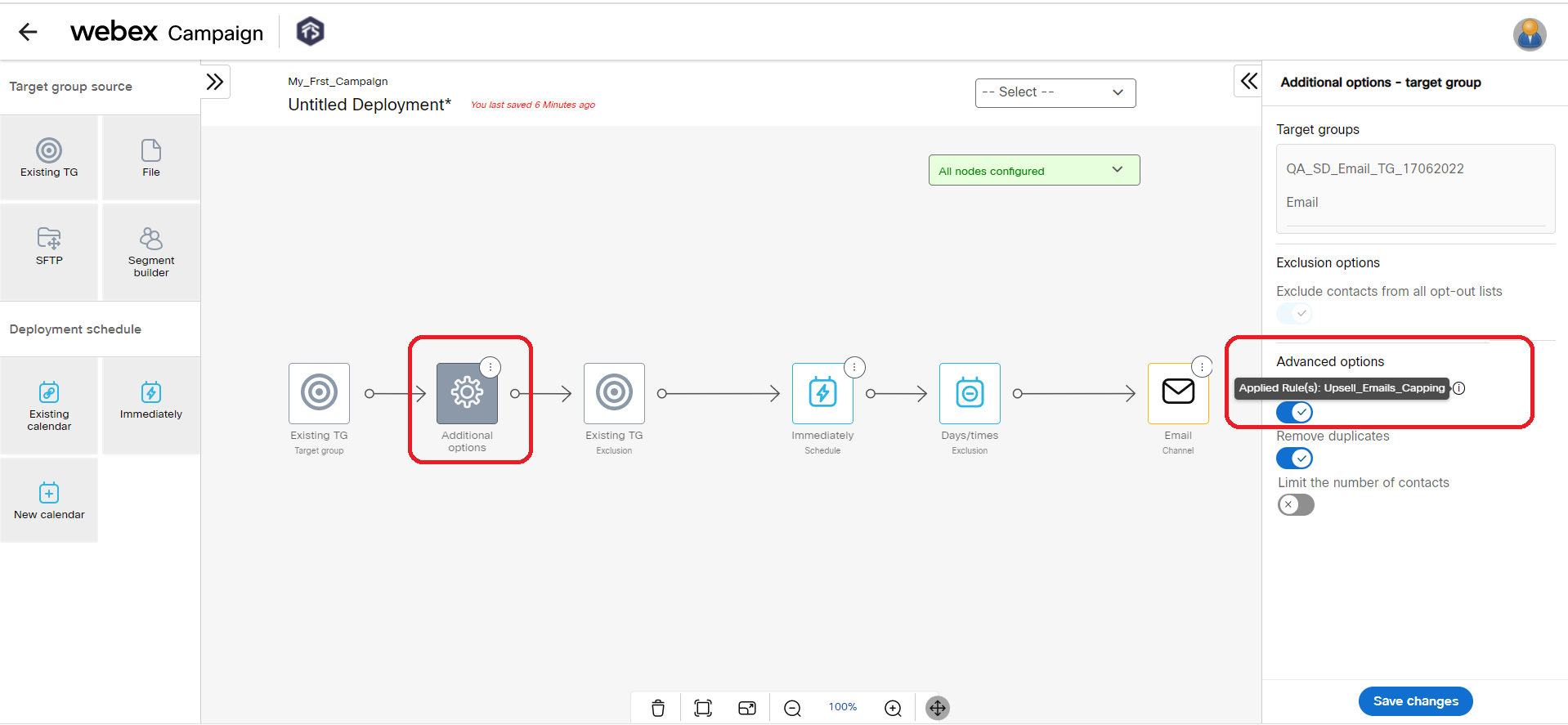
Usage notes for application of contact-frequency-capping rules
-
Frequency capping rules will be active by default when created. You can choose to de-activate or delete rules from the three-dot menu.
-
You can only have 4 active rules for each of SMS/MMS, and Email channels. If there are already 4 active rules for SMS/MMS, or Email channel, you can de-activate an existing rule to create a new rule for the channel.
-
Frequency capping rules are not segregated by User Group and are visible to all users under the tenant.
-
Frequency capping rules are applied (and contacts are suppressed according to the rules) as part of a deployment’s TG preparation process.
-
Frequency capping rules are not applied retroactively to deployments for which the TG-Preparation was already completed. i.e., A rule is applied only to deployments for which the TG will be prepared after a rule became active.
-
While editing a rule, the purpose and channel values cannot be updated. Only messages per day, per week, and per month can be updated.
-
Frequency capping rules are only applicable for deployments with Content Type = Message. It is not applicable for deployments with Content Type = API or File.
-
Frequency capping rule is not available as a feature for MO-triggered instant deployments, Real-time Follow Up deployments, AB Promotion deployments, and AB Follow Up deployments.
-
Frequency capping rule is not applicable for messages sent to seed lists.
-
Frequency capping rule is not applicable to test messages sent from the Preview and test screen.
-
Frequency capping rule is not applicable to Preview test sends for the Auto-Generated test variant messages.
-
Success and Failure Messages sent on top of API success/ failure codes or statuses will not be considered for frequency capping
-
Frequency capping rule is only validated at the time of the 1st batch of a batched deployment.
-
Frequency capping rule will not consider changes if deployments are paused and resumed because in these cases, the TG is already prepared and thus a contact may get an outbound message even if they should be suppressed because of other messages sent through other deployments to them whilst this deployment was paused.
-
Frequency capping rule will not suppress multiple messages to a TG contact if the contact is duplicated in the TG associated with a deployment.
-
Frequency capping rule feature may impact the time taken to prepare the TG for a deployment depending on the TG size and the number of applicable frequency capping rules.
Computing contact-frequency-capping rules
To decide whether to suppress an outbound message to an email / a mobile number based on contact-frequency-capping rules, Webex Campaign will go through the following steps during the TG processing:
- All the frequency capping rules associated with all the ‘Purpose’ meta-tags selected for the deployment are assessed to determine the minimum permitted messages that can be sent to the contacts within the TG for the duration of 1-day, 1-week, and 1-month.
- At the time of TG preparation, the minimum permitted values across all capping rules for 1 day, 1 week, and 1 month durations are compared against the number of messages already sent out to each TG contact for 1 day, 1 week, and 1 month. Only if sending out the message for the current deployment to a specific contact will not violate the minimum permitted values for any of 1 day, 1 week, or 1 month, only then the message is sent out to the TG contact (email or mobile number); otherwise, the message is not sent i.e., “the contact is frequency-capped”.
- After TG has been prepared and messages are pushed out (not delivered) for a deployment, then the counters of the messages sent are incremented by 1 for each of the TG contacts, to whom the message was pushed. These are counters for each applicable ‘Purpose’ meta-tag for messages sent in the last 1-day, 1-week, and 1-month durations.
- These revised message counters are then used for frequency capping comparisons for subsequent deployments.
- Frequency capping counters for TG contacts may take up to 60 minutes to update after the TG contact is processed for a deployment.
- The frequency counts for each contact across 1 day, 1 week, and 1 month durations will be reset as per the following schedule:
o At 00:01 Hrs. tenant time zone every day, the ‘Current 1 Day Tally’ for each contact will be reset to 0 for every purpose, for each channel.
o At 00:01 Hrs. tenant time zone every Monday, the ‘Current Week Tally’ for each contact will be reset to 0 for every purpose, for each channel.
o At 00:01 Hrs. tenant time zone 1st day of every month, the ‘Current Month Tally’ for each contact will be reset to 0 for every purpose, for each channel.
Viewing contact-frequency-capping results on Dashboard & Reports
You will be able to see the count of contacts that were ‘frequency-capped’ on the Dashboard on the ‘Campaign Details’ and ‘Deployment Details’ pages. Similarly, these frequency-capped counts will be shown in reports.
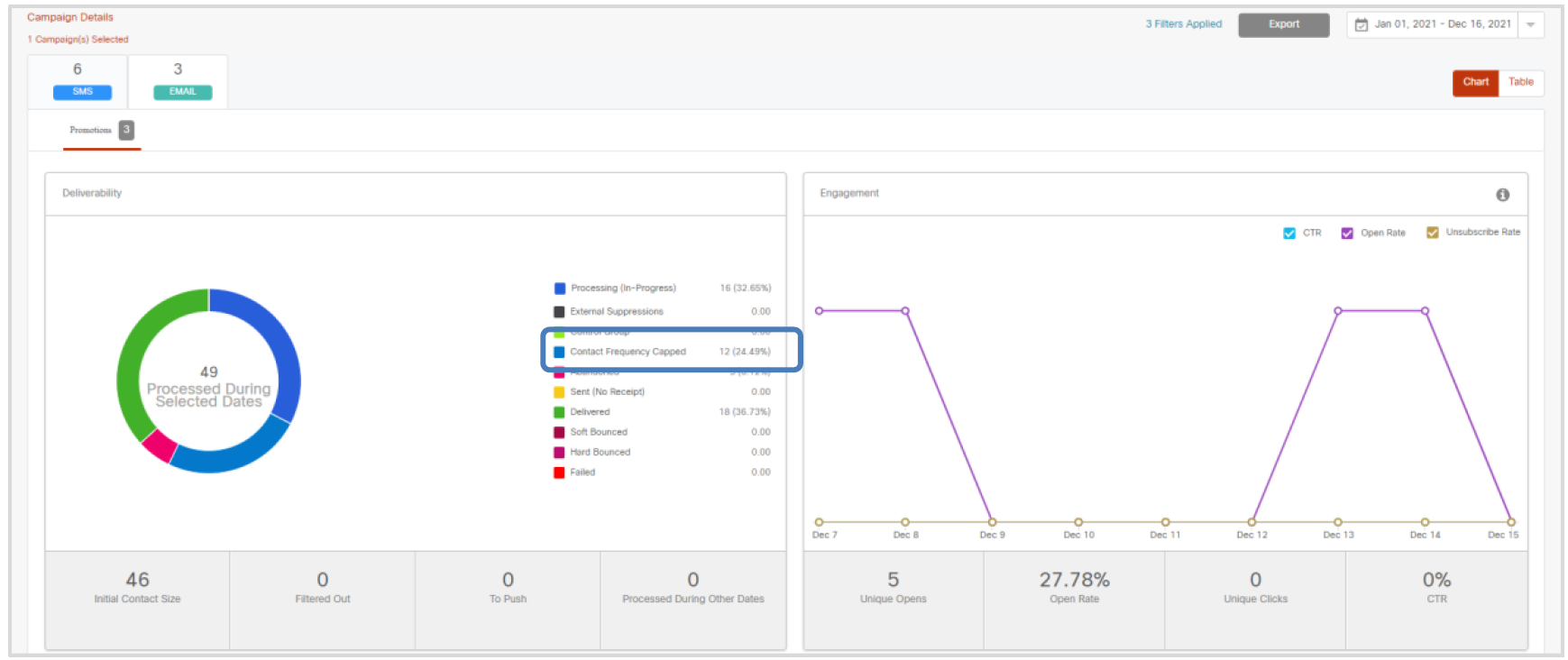
Manage a Rule
The options to manage a rule are available under the ellipses option available for the respective rule.
- On the Contact frequency rules list screen, click the ellipses of the required rule.
- To deactivate a rule, click Deactivate rule.
- To Delete a rule, click Delete rule. A rule must be in an INACTIVE state before being deleted.
- To Edit a rule, click Edit rule and make necessary changes.

Updated 11 months ago